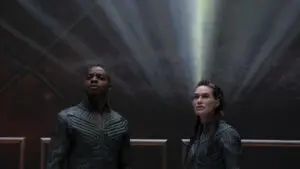The lighthouse is a pretty universally understood symbol for being kept on the right track, so it’s a bit ironic that Beacon 23, which is set on a space lighthouse designed to help ships navigate the vast unknown, is all over the place. The MGM+ series, which is adapted from Hugh Howey’s same-titled novel, wastes an extremely compelling paranoiac premise on an uneven journey from one self-contained sci-fi story to the next.
And yet it’s highly watchable and easily recommendable stuff all the same, mostly because it has no compunctions whatsoever about being weird and daring and inconsistent in a TV landscape that champions safety-first content above all. In space, nobody can collect your viewing figures and cancel you.
Beacon 23 Season 1 Review and Plot Summary
It begins with a crash. A lone ship seemingly malfunctions and crashes near Beacon 23, which is being monitored by one man (Stephan James) who has clearly been there too long. Nevertheless, he drags the sole survivor, Aster (Lena Headey), from the wreckage, treats her to a flavorless space meal, and acts all shifty when she asks him questions.
The key selling point of Beacon 23, at least in its earlier episodes, is that neither of the two protagonists is who they say they are. This doesn’t constitute a spoiler, since it’s blatantly obvious from the get-go and largely the point. The plot is powered by all the unanswered questions that arise as it becomes clearer and clearer that both are lying. Who are they really? What do they want? Why are they there?
The dynamic is complicated further by the presence of the beacon’s AI, BART (voiced by Wade Bogert-O’Brien), and Aster’s personal AI, Harmony (Natasha Mumba), who frequently appears as a hologram. I know what you’re thinking – we’re hearing more than enough about AI in our real lives lately, and it isn’t as if science fiction has ever been shy of the concept. But Beacon 23 has a genuinely engaging interpretation of it, and the four-way dynamic – even though Bogert-O’Brien isn’t even visible – is what keeps the show anchored as a coherent drama.
And it needs this stability. While the focus is better kept on Aster and Halan, the captivating isolation of the bunker is frequently ruined by unexpected visitors and unwelcome narrative deviations, burying the engaging who’s-who core under reams of dense exposition. It’s only the performances that keep rapidly spiraling mythology under some kind of control.
For some, undiscovered elements and potential alien life and politics and spirituality are necessary components of science-fiction, but Beacon 23 can’t be said to necessarily benefit from them. It’s much better as a chamber piece, an exploration of trust set against the unforgiving backdrop of literal nothingness. The format is probably intended to more closely mimic Howey’s novel, which one supposes is unavoidable, but artistic license exists for a reason. It could have been utilized more liberally here.
Beacon 23 is messy and uneven — but you should stream it anyway
Still, as above, there’s something about Beacon 23’s excitement for its own setting and ideas that makes it worthwhile entertainment, even if the setting isn’t used to its potential and the ideas often aren’t worth having.
Some of the individual stories take up entire episodes and are worthwhile; some are background seasoning and aren’t. Almost everyone who tunes in will take away different things, and mileage will vary more than usual. But it almost feels refreshing to be typing this about something. Why shouldn’t a streaming show swing for the bleachers a little bit and just see where the ball lands?
A second season has already been confirmed, and a much bigger, more wide-ranging, and calculated narrative has already been hinted at, so why not hop along for the ride?
What did you think of Beacon 23 Season 1? Let us know in the comments.
RELATED: Beacon 23 Season 1 Episode 3 Recap

